Politics
How has the SCO summit impacted the global energy landscape?

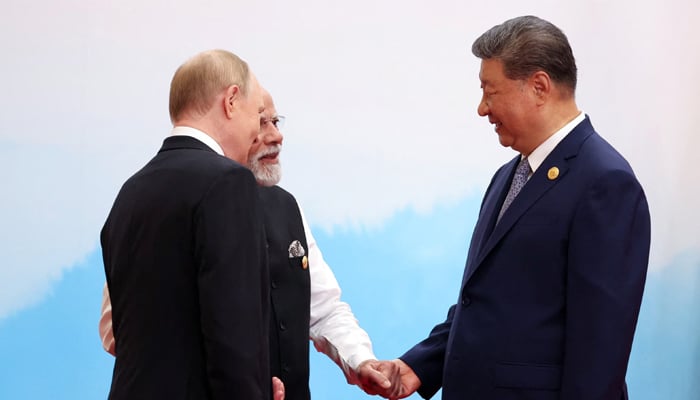
China put energy co-operation centre stage at the recent Shanghai Co-operation Organisation (SCO) meetings in Tianjin. President Xi Jinping announced that China will invest in building 10 gigawatts (GW) of solar and 10 GW of wind power across SCO member countries over the next five years.
What is the Shanghai Co-operation Organisation?
This represents a large increase on the 1 GW of solar and 0.3 GW of wind China has invested in SCO states since 2019. At the same time, tacit support was given to the Power of Siberia-2 gas pipeline, which if built could push the Russian share of China’s gas imports up to a third by the 2030s.
So how will China’s energy investments influence the energy transitions of SCO member states? And does China’s co-operation with Central Asian countries and energy giant Russia signal a profound shift in the global energy landscape?
To answer these questions, Dialogue Earth spoke with experts from China, India, Pakistan and Finland.
Lauri Myllyvirta: China’s recent pledge to develop 10 GW of wind and 10 GW of solar power projects across SCO countries represents a potentially important step forward in its overseas energy engagement.

Chinese manufacturers have long dominated global solar power equipment supply, but the vast majority of the equipment is used in projects with no Chinese involvement in project development or financing. The pledge could serve as an opportunity for Chinese power companies and project developers to extend their presence beyond equipment exports. It could help them accelerate renewable-energy deployment abroad by drawing on the expertise they have built in scaling up clean energy at home.
At present, China’s involvement in overseas clean energy remains largely confined to bidding for projects already included in host-country energy plans. The new pledge could create an opening for China to engage more deeply in dialogue with partner governments beyond discrete projects.
This dialogue could shape broader national energy planning by combining renewable generation with storage, transmission and equipment manufacturing. Such a shift would not only strengthen the position of Chinese developers internationally, but also help partner countries to raise their ambitions for renewable-energy deployment.
Since 2019, China has invested in 10.4 GW of solar and 7.6 GW of wind overseas. Within SCO countries, however, investment has been far more modest, just 1.0 GW of solar and 0.3 GW of wind over the same period. This suggests both the relatively limited scale so far and the significant potential for Chinese investors to expand clean energy deployment in these markets.
In 2024, Pakistan imported 17 GW of solar panels. India added roughly 28 GW of wind and solar, and even Uzbekistan brought online about 1.8 GW of solar. Given these countries’ rapidly growing energy needs, a collective target of 10 GW each for solar and wind across all SCO countries over five years represents only a small fraction of their overall demand.
One caveat is that investing in Russia, a member of the SCO, while it continues its illegal war of aggression against Ukraine would carry serious reputational, diplomatic and ethical risks. Pursuing clean-energy co-operation in other SCO member states — many of which have pressing needs to diversify their energy mix, improve energy security and lower emissions — would both reinforce China’s clean-energy leadership and demonstrate alignment with global climate goals.
In sum, the 10+10 GW initiative can move Chinese overseas engagement from equipment export and project bidding towards systemic co-operation and energy planning. This way, it could meaningfully advance clean-energy transitions in SCO countries while strengthening China’s role as a global clean-energy partner.
Xie Cheng Kai: The SCO summit saw new “energy and green-industry” platforms announced and a new development bank floated. While these initiatives are still at an early stage, the more substantive progress is evident in gas pipeline projects and financial integration. These reflect China’s long-term efforts to diversify and strengthen its position in global energy and finance.
The revival of the Power of Siberia-2 pipeline is the clearest example. Gazprom’s CEO said a memorandum of understanding (MoU) has been signed, though China has not confirmed this. The Chinese foreign ministry spoke only of “actively promoting cross-border infrastructure and energy projects” with Russia and Mongolia. No contract price, timeline or precise volume has been disclosed. Yet symbolism matters.

Like Power of Siberia-1, which gained political momentum years before terms were finalised, the second iteration has shifted from stagnation to motion.
If realised, it could deliver 50 billion cubic metres annually and push Russia’s share of China’s gas imports to a third by the 2030s. For now, the pipeline is best read as a geopolitical signal rather than a commercial certainty. Whether it moves from MoU to reality will depend much on the terms China can extract and Moscow can accept.
Unlike in oil, where China has avoided heavy dependence on one supplier, in gas it appears willing to accept concentration because it delivers options in a world where the United States remains the largest liquefied natural gas (LNG) exporter. Overland Russian supply could offer China a useful hedge against over-reliance on US LNG and the Western financial architecture that underpins it.
India, too, continues buying discounted Russian crude despite new US tariffs, as highlighted by the warm optics of Putin’s recent meeting with Modi in China. The message is that China is not isolated. Others in Asia are also resisting US pressure.
Finance is the parallel frontier. According to the Financial Times, Chinese regulators told Russian energy firms they can issue renminbi-denominated “panda bonds” in China’s domestic market – the first such issuance since 2017. Coupled with the fact that more than 90% of bilateral trade already settles in roubles and renminbi, this deepens Moscow’s dependence on China’s financial system and provides a sanctions-resistant funding channel for pipelines and LNG logistics. It also advances Beijing’s strategic goal of renminbi internationalisation, embedding energy security within financial sovereignty.
Pipelines, panda bonds and LNG defiance illustrate that China is embedding energy security and financial sovereignty in closer alignment with Moscow, while India’s continued purchases show it is not acting alone. The market impact may not be immediate, but the political signal is hard to miss.
Li Yuxiao: Achieving the wind and solar power goals outlined in the SCO meetings will require a great deal of active collaboration across the entire industrial chain. This includes the manufacturing of wind and solar photovoltaic tech, and financing from Chinese investors.

Even as China’s domestic wind and solar capacity booms, Chinese investors still face serious obstacles to invest in wind and solar projects abroad. They will require stronger policy support for implementation and insurance.
In our work in Beijing, we have for years spoken to Chinese investors, enterprises and banks who express keen interest in wind and solar but are faced with a lack of effective financial mechanisms and limited risk coverage. Chinese investors looking at overseas wind and solar projects face limited financing structures, inflexible insurance guarantees, lengthy approval processes and a fragmented regulatory system not aligned with international technical standards. All this inhibits investments.
The 10+10 GW targets would involve the whole industry chain for wind and photovoltaic. The industrial strategy behind this agreement has of course received a lot of attention. But while much attention has gone to the strategic “offloading” function of such agreements for China’s clean-tech industries, this particular agreement’s inclusion of “technology transfer” and “experience exchange” stands out.
This is an area that will be of strategic interest for member countries. Indeed, the member countries’ response statements give greater emphasis to these elements. If effective technology transfer and experience exchange occurs between China and partners in the Global South, it could significantly support local-industry development from the ground up. Ultimately it could benefit regional energy structures and advance the energy transition both locally and globally.
Ruchita Shah: India’s participation in the SCO summit reflects a willingness to engage in energy co-operation, as China seeks to shape the forum into a platform for green-technology collaboration. For New Delhi, this engagement could indeed help streamline trade and knowledge sharing on green technologies.
But it will remain cautious in order to protect its domestic supply-chain reforms. It will continue pursuing diversification to prevent falling into new dependencies.

And it will emphasise ensuring that co-operation creates value within India through technology transfer, finance and joint research and development, rather than simply expanding import flows.
Chinese solar photovoltaic modules have been crucial in driving India’s installed solar capacity up to its current 120 GW.
Meanwhile, domestic manufacturing of solar panels has expanded rapidly from 2.3 GW in 2014 to 100 GW by 2025. But India still depends on China both for solar cells, which are the building blocks of solar panels, and for battery components. Though a Production Linked Incentive scheme has been launched to support domestic battery-manufacturing capacity.
Meanwhile, India’s growing fossil-fuel imports need to be seen in the context of its broader energy transition. As the world’s fastest-growing major economy, it needs to balance rising development-driven energy demand with supply security. Oil demand will continue to rise in the medium term, even as electrification gathers pace. There is no official climate target linked to reducing oil consumption. Instead, India’s climate commitments focus on expanding renewable energy, reducing emissions intensity and reaching net zero by 2070. Higher oil imports today do not contradict its climate targets, as they are framed around reshaping the power mix and improving efficiency, largely by reducing reliance on coal.
India’s influence in energy and climate discussions extends beyond its reliance on imports. Renewables already make up half of its installed power capacity and it is targeting 365 GW of solar and 140 GW of wind by 2032. Electrification in transport, agriculture and domestic energy use is accelerating. At the same time, policies such as the Approved List of Models and Manufacturers and the Production Linked Incentive schemes for solar, batteries and green hydrogen are trying to localise supply chains and reduce import dependence.
Over the years, India has built a supportive policy environment for the energy transition. Competitive renewable auctions have consistently delivered some of the world’s lowest tariffs, helping shape international price benchmarks and procurement models in other emerging economies. India also co-founded and leads the International Solar Alliance, now joined by over 120 countries, highlighting its role in shaping global clean-energy governance. Its advocacy in multilateral forums emphasises equitable, sustainable transitions for emerging economies. The SCO’s 2025 declaration also recognised India’s global vision of “One Earth, One Family, One Future,” reaffirming its leadership in promoting inclusive and sustainable development.
Omais Abdur Rehman: This year’s SCO summit drew unprecedented attention due to shifting global dynamics.
The US has imposed heavy tariffs on China and India, and it is putting pressure on Russia to end the conflict in Ukraine, and pressure on India not to buy oil from Russia. SCO member states therefore began signalling interest in a parallel global system. China especially has felt the need for an alternative. This was also the first summit with both heads of state of India and Pakistan present since the recent military conflict between the countries.

India, frustrated by external interference, including Trump’s claims of mediation on Pakistan-India tensions, appeared to recalibrate its posture, hinting at openness to Chinese infrastructure support. China seized the moment, hosting the largest SCO summit to date, with 24 heads of state, and outlining expansive ambitions for the bloc beyond symbolic diplomacy.
Climate co-operation emerged as a key theme. China proposed a new SCO development bank, and pledged CNY 2 billion in grants and CNY 10 billion in loans. Russia backed the multilateral approach, reinforcing a shared stance against hegemonism. However, despite the urgency, especially with Pakistan and India facing severe climate disasters, the summit lacked concrete mechanisms for joint climate action or immediate relief.
For Pakistan, the summit signals a potential pivot. The approval of the SCO Development Strategy 2035 and of the proposed SCO development bank offers alternatives to International Monetary Fund and World Bank financing.
Aligning with SCO’s broader development goals, Chinese and Pakistani leaders emphasised opening up new opportunities under the China-Pakistan Economic Corridor (CPEC) for industrial, agricultural, energy and digital co-operation. Pakistan’s prime minister officially announced the launch of CPEC 2.0. Further, the Second Pakistan-China B2B Investment Conference saw focus on not just electric vehicles, petrochemicals and iron and steel, but also health and agriculture.
Pakistan is likely to deepen its engagement with China to advance its energy transition through decreased reliance on fossil-fuel assets. It is time for China to move towards the phase-out and early retirement of coal in Pakistan as well as other countries. The SCO can help China to focus on these goals.
Amid the strained relationship between India and Pakistan, climate resilience presents a rare opportunity for collaboration. The present floods in both countries have yet again proven this is not an option but a necessity.
The continued India-Pakistan tensions, along with the failure to present a joint climate-action plan at the summit, remain critical challenges. But the SCO provided a platform for both countries to discuss possible transboundary collaboration.
This article was originally published on the Dialogue Earth website under a joint byline including Lin Zi and Shalinee Kumari. It has been reproduced on Geo.tv with permission.
Farahnaz Zahidi Moazzam is a Karachi-based journalist whose work focuses human-centric feature stories, environmental issues like solid-waste management, blue carbon, and water initiatives in South Asia.
Shalinee Kumari is an Indian journalist based in New Delhi who has keen interest in the intersection of climate with gender, caste, culture, politics and economy.
Lin Zi is a London-based journalist with over a decade of experience in climate change and environmental policy-related work.
Politics
Trump lands in South Korea, says Xi talks will be ‘great outcome for world’
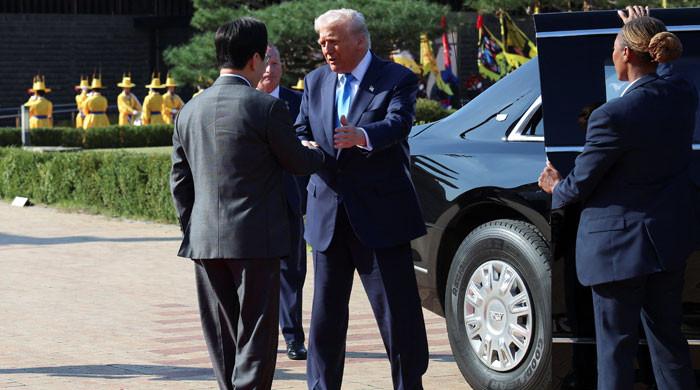
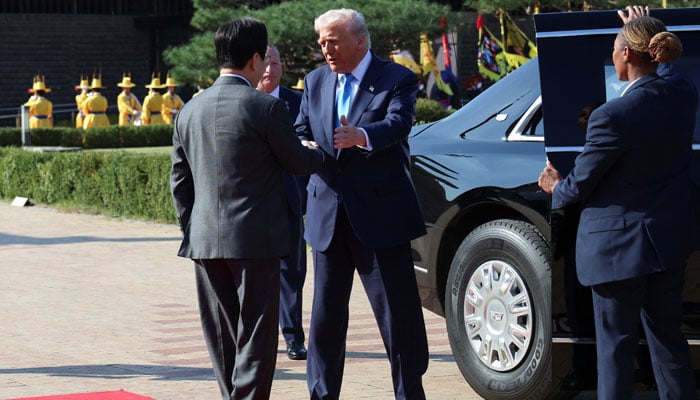
- US president makes final stop on Asia trip.
- Meetings with China’s Xi, South Korea’s Lee expected.
- Trump expects to cut China tariff related to illicit fentanyl trade.
GYEONGJU: US President Donald Trump landed in South Korea on Wednesday for the final leg of his Asia trip, optimistic about striking a trade war truce with Chinese President Xi Jinping after summit talks with South Korea’s Lee Jae Myung.
Arriving from Tokyo hours after North Korea test-fired a nuclear-capable cruise missile, Trump is due to address a summit of CEOs and meet with Lee in Gyeongju, a sleepy South Korean town filled with historic tombs and palaces.
The main item on Wednesday’s agenda will be the unresolved trade agreement between the US and South Korea, before an expected meeting with Xi on Thursday, the prospect of which has already buoyed global markets.
Speaking to reporters aboard Air Force One en route to Gyeongju, Trump dismissed the North Korea missile test and said he was squarely focused on his meeting with the leader of the world’s second-largest economy.
“The relationship with China is very good. So I think we’re going to have a very good outcome for our country and for the world, actually,” Trump said.
He expects to reduce US tariffs on Chinese goods in exchange for Beijing’s commitment to curb exports of fentanyl precursor chemicals, he added. The US could halve the 20% levies on Chinese goods it currently charges in retaliation for the export of such chemicals, the Wall Street Journal reported.
After arriving in the southern city of Busan, Trump was greeted by officials and a cannon salute on the red carpet, before a band struck up a rendition of Village People’s YMCA, a favourite of the US president’s often played at his rallies. He was then whisked to Gyeongju in his helicopter.
South Korea trade talks struggle
Trump made no mention of trade talks with South Korea on Wednesday, with both sides playing down the prospect of a breakthrough in leader talks.
The two allies announced a deal in late July under which South Korea would avoid the worst of the tariffs by agreeing to pump $350 billion of new investments into the United States. But talks over the structure of those investments have been deadlocked.
Trump has also pressed allies like South Korea to pay more for defence, and South Korea has sought reforms to US immigration laws to allow for more workers to build factories after a raid on a Hyundai Motor 005380.KS battery plant in Georgia.
The leaders will discuss trade, investment and peace on the Korean peninsula at talks on Wednesday, Lee’s office said, a reference to engagement with North Korea.
Trump has made repeated calls for a meeting with North Korean leader Kim Jong Un, including during this trip, but there has been no public comment from Pyongyang. Kim has previously said he could be open to talking if Washington stops pressing him to give up nuclear weapons.
Adding to the golfing gifts he received from Japan’s leader in Tokyo on Tuesday, Lee will present Trump with a replica gold crown and award him with the “Grand Order of Mugunghwa”, the country’s highest decoration.
A “golden dessert” is on the menu for their working lunch, Lee’s office said.
Taiwan on the agenda?
Skipping the main APEC summit, Trump will address the APEC CEO summit, have dinner with Lee and hold bilateral meetings with several countries’ leaders, including China’s Xi, before departing on Thursday.
Negotiators from the world’s top two economies hashed out a framework on Sunday for a deal to pause steeper American tariffs and Chinese rare earths export controls, US officials said. The news sent stocks soaring to record peaks.
Taiwan Foreign Minister Lin Chia-lung said on Tuesday he was not worried that Trump would “abandon” the island in his meeting this week with Xi.
Since taking office in January, Trump has vacillated on his position towards China-claimed Taiwan as he seeks to strike a trade deal with Beijing. Trump says Xi has told him he will not invade Taiwan while the Republican president is in office, but Trump has yet to approve any new US arms sales to Taipei.
China said on Wednesday it “absolutely will not” rule out using force over Taiwan.
Trump told reporters on Wednesday that he did not know whether he would even discuss Taiwan with Xi.
Politics
Two held in Sharjah for stealing Dh195,000 with ‘faulty tyre’ trick


Two men who allegedly stole Dh195,000 from a woman after distracting her with a “faulty tyre” trick were arrested within three hours, police said on Tuesday.
The woman had withdrawn the cash from a bank in Fujairah, an emirate on the UAE’s eastern coast along the Gulf of Oman, and placed it inside her car.
The suspects followed her, and as she stopped, one man approached claiming that one of her tyres was damaged.
When she got out to check, the second suspect opened the car door, grabbed the cash, and both men fled.
Police said the complaint was received at 10:50am, and after quick coordination with Sharjah Police, the suspects were traced and arrested in Sharjah, an emirate about 100 kilometres west of Fujairah.
Officials said the pair were also wanted for similar thefts in other emirates.
Authorities have urged residents to remain vigilant after withdrawing cash and to avoid engaging with strangers outside banks.
Politics
Hurricane Melissa makes landfall in Jamaica
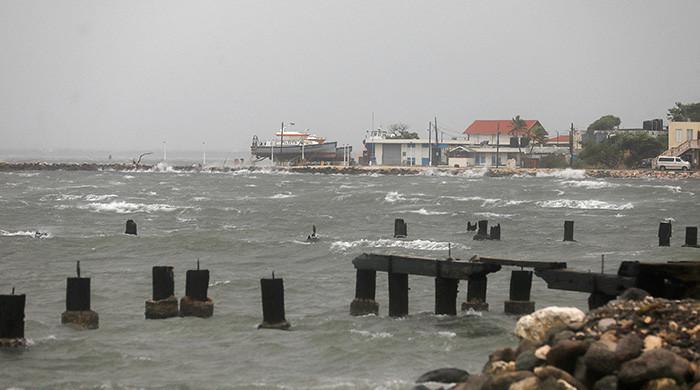
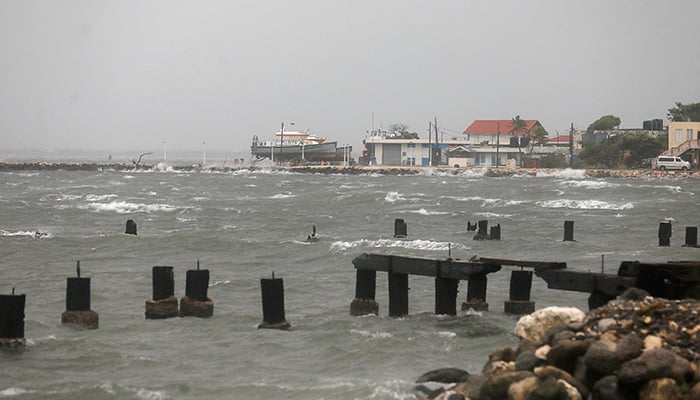
Hurricane Melissa made landfall in Jamaica on Tuesday as a category five hurricane, the US National Hurricane Center (NHC) said in its latest advisory.
It was one of the most powerful hurricane landfalls on record in the Atlantic basin, the NHC added.
Jamaica’s ‘storm of the century’
Earlier, the US National Hurricane Center said that the Category 5 storm, the strongest possible on the Saffir-Simpson scale, was about 55 km (34 miles) southeast of the Jamaican resort town of Negril as of 1600 GMT and packing maximum sustained winds of 295 km per hour (183 miles per hour), with even higher gusts.
The Miami-based hurricane centre warned that “total structural failure” was likely in Melissa’s path.
“It’s a catastrophic situation,” the World Meteorological Organisation’s tropical cyclone specialist Anne-Claire Fontan told a press briefing. “For Jamaica, it will be the storm of the century for sure.”
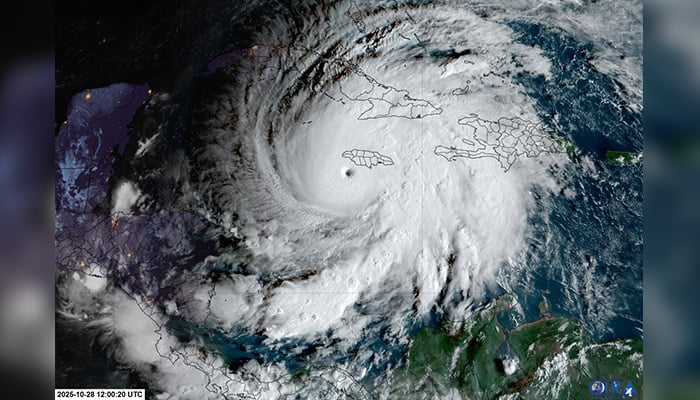
Storm surges of up to four meters were expected, she said, with rainfall set to exceed 70 cm (2.3 feet), causing “catastrophic flash flooding and landslides,” she said.
Nearby Haiti and the Dominican Republic have faced days of torrential downpours leading to at least four deaths, authorities said. At least three people died during storm preparations in Jamaica, local media reported.
The NHC expects the storm to hit Jamaica on Tuesday and remain as a strong hurricane when it crosses eastern Cuba to move over the Bahamas and Turks and Caicos by Wednesday.
Bahamian Prime Minister Philip Davis has ordered evacuations for people in southern and eastern parts of the archipelago.
In Cuba, authorities said they had evacuated upwards of 500,000 people from areas vulnerable to winds and flooding.
Storm intensified on approach
Melissa’s slow movement over unusually tepid Caribbean water had contributed to its ballooning size and strength, NHC forecasters said, threatening Jamaica with days of never-before-seen catastrophic winds and rain.
Melissa could bring up to 30 inches (762 mm) of rain to parts of Jamaica, and up to 12 inches to parts of the island of Hispaniola, the NHC said.
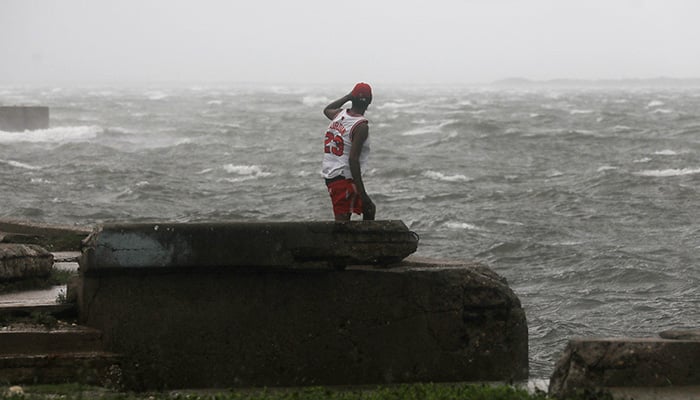
The International Federation of the Red Cross said up to 1.5 million people in Jamaica were expected to be directly affected by the storm.
“Today will be very difficult for tens of thousands, if not millions of people in Jamaica,” IFRC official Necephor Mghendi said via video link from Port of Spain in Trinidad and Tobago.
“Roofs will be tested, flood waters will rise, isolation will become a harsh reality for many.”
To enable swift relief distribution, essential items — tarpaulins, hygiene kits, blankets, and safe drinking water — had been pre-positioned in Red Cross branches on the island, he said, with over 800 shelters set up for evacuees.
On Monday, Prime Minister Andrew Holness ordered mandatory evacuations for parts of southern Jamaica, including the historic town of Port Royal.
He warned of damage to farmlands, homes, and infrastructure on the island, which is roughly the size of Connecticut and whose main airports sit close to sea level.
“There is no infrastructure in the region that can withstand a Category 5,” he said.
Holness said his government was as prepared as possible, with an emergency response budget of $33 million and insurance and credit provisions for damage a little larger than that sustained from Beryl.
Beryl was the earliest and fastest Atlantic hurricane on record to reach Category 5, but scientists warn that storms are becoming stronger and faster as a result of climate change warming ocean waters.
“Slow-moving major hurricanes often go down in history as some of the deadliest and most destructive storms on record,” said AccuWeather Chief Meteorologist Jonathan Porter. “This is a dire situation unfolding in slow motion.”
-

 Fashion1 week ago
Fashion1 week agoChinese woman charged over gold theft at Paris Natural History Museum
-

 Entertainment1 week ago
Entertainment1 week agoJohn Grisham unveils his first-ever mystery, “The Widow”
-

 Tech1 week ago
Tech1 week agoThis Smart Warming Mug Is Marked Down by $60
-

 Fashion1 week ago
Fashion1 week agoeBay UK seller fee removal sends revenue down but profits rise
-

 Tech1 week ago
Tech1 week agoEaster Island’s Moai Statues May Have Walked to Where They Now Stand
-

 Fashion1 week ago
Fashion1 week agoThe North Face and Cecilie Bahnsen launch second collaboration
-

 Tech1 week ago
Tech1 week agoOpenAI has slipped shopping into ChatGPT users’ chats—here’s why that matters
-
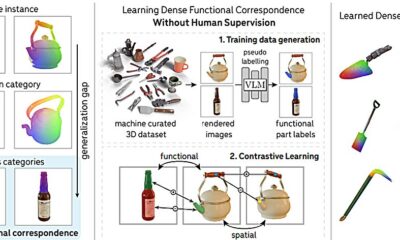
 Tech1 week ago
Tech1 week agoAI model could boost robot intelligence via object recognition






